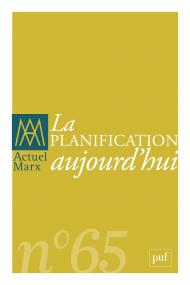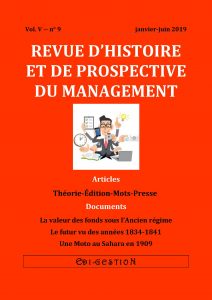Les ressources naturelles ont été souvent analysées dans la littérature économique comme étant non compatibles avec le développement économique (Auty, 2001 ; Gylfason, 2001 ; Sacks & Warner, 1995). L’objet de ce papier est de revenir sur l’analyse du lien qui caractérise les ressources naturelles et le développement économique. Pour ce faire, nous mobilisons une nouvelle approche basée sur les théories évolutionnistes et institutionnelle qui porte la focale sur l’importance de la dynamique d’apprentissage et de création de …[Lire la suite]
Actuel Marx 2019/1 – La Planification aujourd’hui
cordonné par Cédric Durand (CEPN) et Razmig Keucheyan (Centre Emile Durkheim)

Dossier – La Planification aujourd’hui, coordonné par Cédric Durand et Razmig Keucheyan
La Planification est de retour
Le capitalisme est à nouveau en crise, une …[Lire la suite]
Working Paper n°2019-05 – Least Impulse Response Estimator for Stress Test Exercises – Christian Gouriéroux and Yang Lu
We introduce new semi-parametric models for the analysis of rates and proportions, such as proportions of default, (expected) loss-given-default and credit conversion factor encountered in credit risk analysis. These models are especially convenient for the stress test exercises demanded in the current prudential regulation. We show that the Least Impulse Response Estimator, which minimizes the estimated effect of a stress, leads to consistent parameter estimates. The new models with their associated estimation method are compared with the other …[Lire la suite]
Working Paper n°2019-04 – Une analyse de la nature de l’investissement immatériel par le rapport capital / travail – Alexis Jeamet
Cet article propose de revisiter le concept d’investissement immatériel en posant la question de la nature de celui-ci. Ce travail d’inspiration marxienne analysera la transformation de la nature de l’investissement immatériel en partant des transformations du rapport capital / travail. À partir des modifications de ce rapport identifiées grâce à la notion de subsomption du travail au capital, nous chercherons à appréhender la nature de l’investissement immatériel au travers du rapport actifs / ressources immatérielles. L’identification de ces …[Lire la suite]
Working Paper n°2019-03 – A theory of predatory welfare state and citizen welfare: the french case – Philippe Batifoulier, Nicolas Da Silva, and Mehrdad Vahabi
In this paper, we argue that the welfare state is an outcome of modern mass (total) warfare. The total war economy requires the participation of all citizens, erasing the difference between the military and citizens. Consequently, the war economy benefits from supporting the civilian population. The total war effect explains why a predatory state undertakes welfare programs. This is one of the contributions of the present paper.
While welfare state is closely related to total warfare, social …[Lire la suite]
Working Paper n°2019-02 – Coupling Cycle Mechanisms: Minsky debt cycles and the Multiplier-Accelerator – S. Devrim Yilmaz & Engelbert Stockhammer
While there exists a substantial literature on different business cycle mechanisms, there is little literature on economies with more than one business cycle mechanism operating and the relation of stability of these subsystems with the stability of the aggregate system. We construct a model where a multiplier-accelerator subsystem in output-investment space (a real cycle) and a Minskyian subsystem in investment- debt space (a financial cycle) can generate stable/unstable cycles in 2D in isolation. We then derive a theorem …[Lire la suite]
Working Paper n°2019-01 – Degrowth in a neo-Kaleckian model of growth and distribution? A theoretical compatibility and stability analysis – Antoine Monserand
Situated at the interface between post-Keynesian and ecological economics, this article investigates the theoretical possibilities for a degrowth transition to take place while preserving macroeconomic stability. More precisely, the objective is to find whether in a neo-Kaleckian model of growth and distribution an equilibrium with a zero or even negative rate of accumulation can coexist with the Keynesian stability condition being verified. Our results are threefold. First, we confirm that adding the rate of depreciation to the canonical …[Lire la suite]
